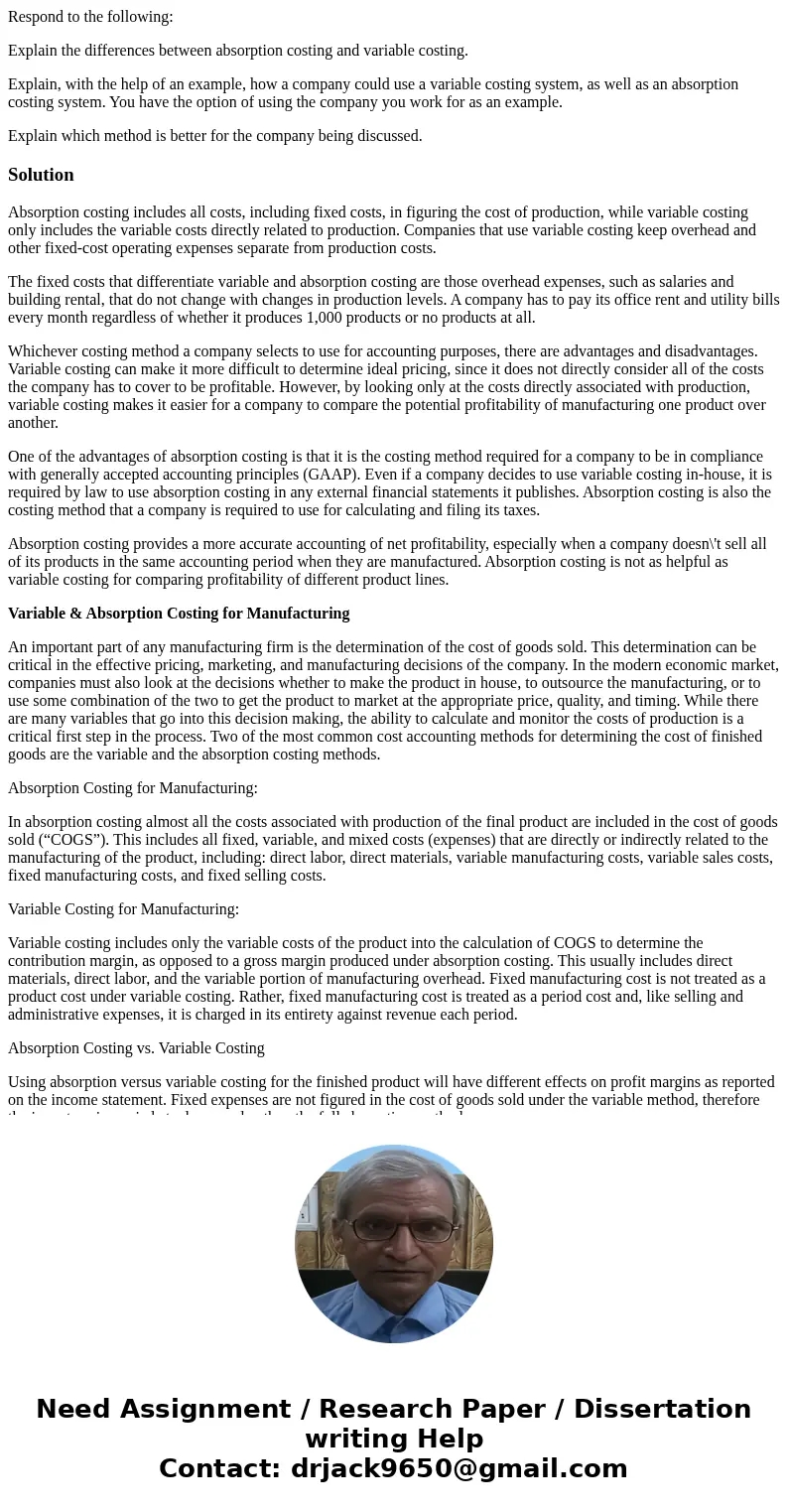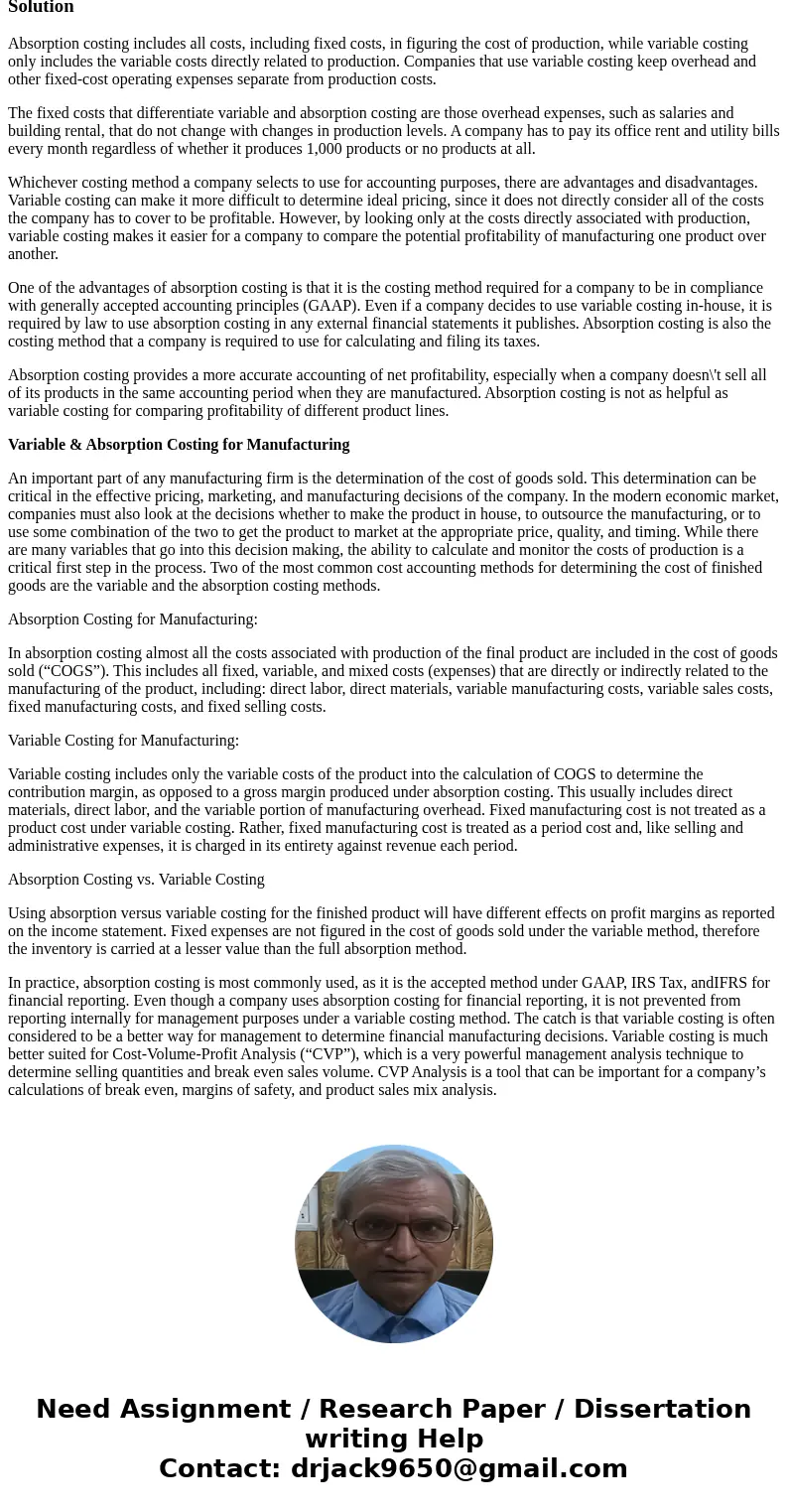Respond to the following Explain the differences between abs
Respond to the following:
Explain the differences between absorption costing and variable costing.
Explain, with the help of an example, how a company could use a variable costing system, as well as an absorption costing system. You have the option of using the company you work for as an example.
Explain which method is better for the company being discussed.
Solution
Absorption costing includes all costs, including fixed costs, in figuring the cost of production, while variable costing only includes the variable costs directly related to production. Companies that use variable costing keep overhead and other fixed-cost operating expenses separate from production costs.
The fixed costs that differentiate variable and absorption costing are those overhead expenses, such as salaries and building rental, that do not change with changes in production levels. A company has to pay its office rent and utility bills every month regardless of whether it produces 1,000 products or no products at all.
Whichever costing method a company selects to use for accounting purposes, there are advantages and disadvantages. Variable costing can make it more difficult to determine ideal pricing, since it does not directly consider all of the costs the company has to cover to be profitable. However, by looking only at the costs directly associated with production, variable costing makes it easier for a company to compare the potential profitability of manufacturing one product over another.
One of the advantages of absorption costing is that it is the costing method required for a company to be in compliance with generally accepted accounting principles (GAAP). Even if a company decides to use variable costing in-house, it is required by law to use absorption costing in any external financial statements it publishes. Absorption costing is also the costing method that a company is required to use for calculating and filing its taxes.
Absorption costing provides a more accurate accounting of net profitability, especially when a company doesn\'t sell all of its products in the same accounting period when they are manufactured. Absorption costing is not as helpful as variable costing for comparing profitability of different product lines.
Variable & Absorption Costing for Manufacturing
An important part of any manufacturing firm is the determination of the cost of goods sold. This determination can be critical in the effective pricing, marketing, and manufacturing decisions of the company. In the modern economic market, companies must also look at the decisions whether to make the product in house, to outsource the manufacturing, or to use some combination of the two to get the product to market at the appropriate price, quality, and timing. While there are many variables that go into this decision making, the ability to calculate and monitor the costs of production is a critical first step in the process. Two of the most common cost accounting methods for determining the cost of finished goods are the variable and the absorption costing methods.
Absorption Costing for Manufacturing:
In absorption costing almost all the costs associated with production of the final product are included in the cost of goods sold (“COGS”). This includes all fixed, variable, and mixed costs (expenses) that are directly or indirectly related to the manufacturing of the product, including: direct labor, direct materials, variable manufacturing costs, variable sales costs, fixed manufacturing costs, and fixed selling costs.
Variable Costing for Manufacturing:
Variable costing includes only the variable costs of the product into the calculation of COGS to determine the contribution margin, as opposed to a gross margin produced under absorption costing. This usually includes direct materials, direct labor, and the variable portion of manufacturing overhead. Fixed manufacturing cost is not treated as a product cost under variable costing. Rather, fixed manufacturing cost is treated as a period cost and, like selling and administrative expenses, it is charged in its entirety against revenue each period.
Absorption Costing vs. Variable Costing
Using absorption versus variable costing for the finished product will have different effects on profit margins as reported on the income statement. Fixed expenses are not figured in the cost of goods sold under the variable method, therefore the inventory is carried at a lesser value than the full absorption method.
In practice, absorption costing is most commonly used, as it is the accepted method under GAAP, IRS Tax, andIFRS for financial reporting. Even though a company uses absorption costing for financial reporting, it is not prevented from reporting internally for management purposes under a variable costing method. The catch is that variable costing is often considered to be a better way for management to determine financial manufacturing decisions. Variable costing is much better suited for Cost-Volume-Profit Analysis (“CVP”), which is a very powerful management analysis technique to determine selling quantities and break even sales volume. CVP Analysis is a tool that can be important for a company’s calculations of break even, margins of safety, and product sales mix analysis.


 Homework Sourse
Homework Sourse